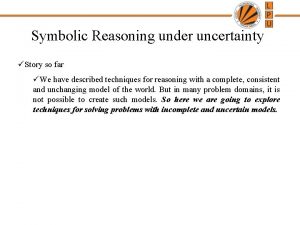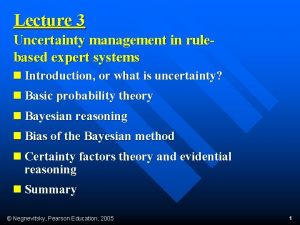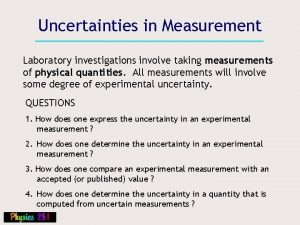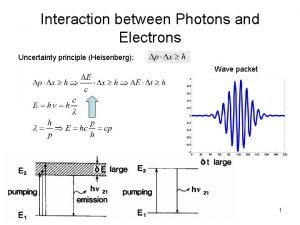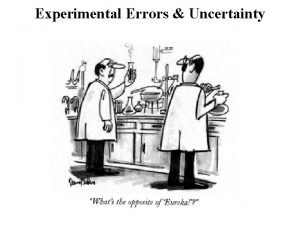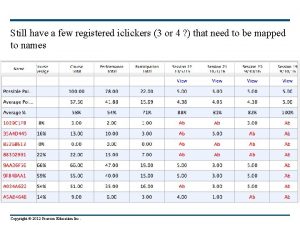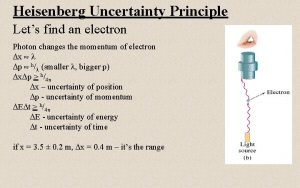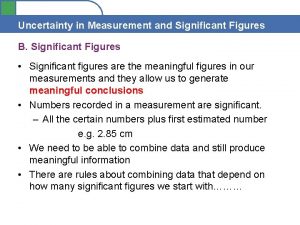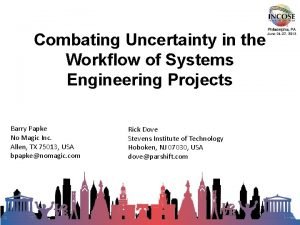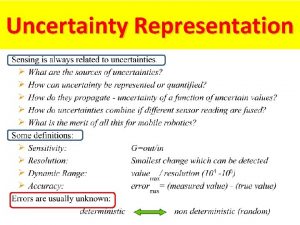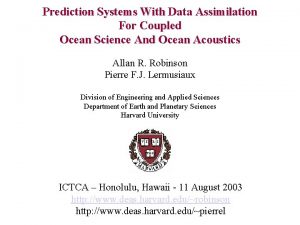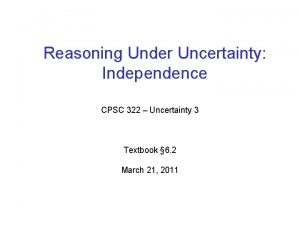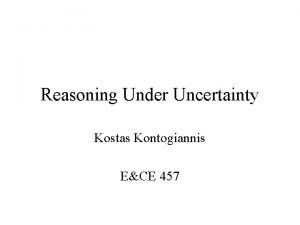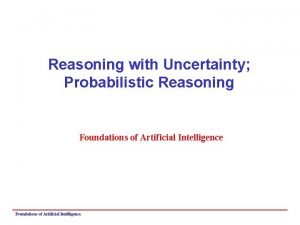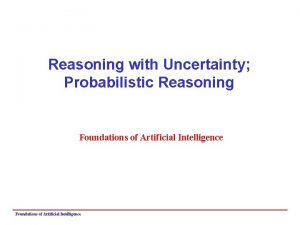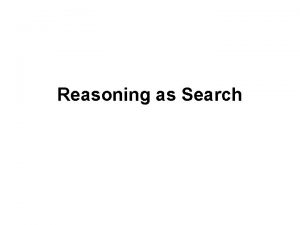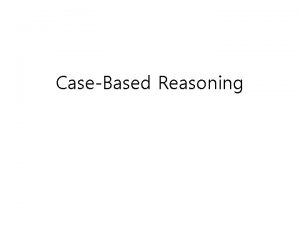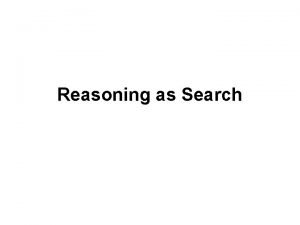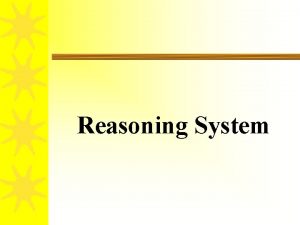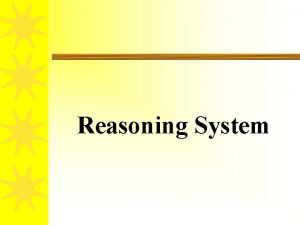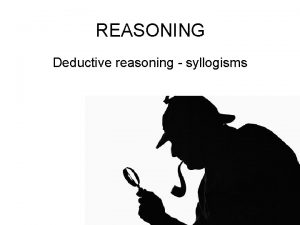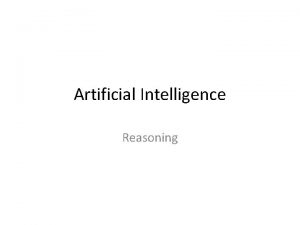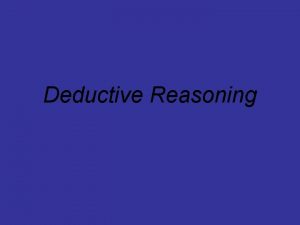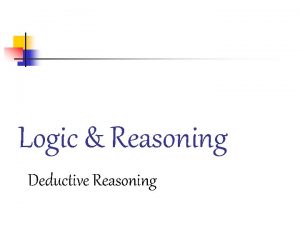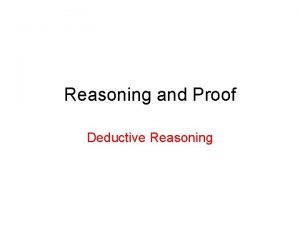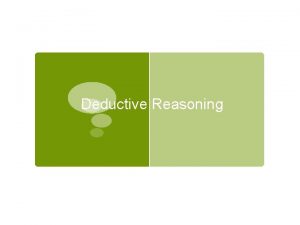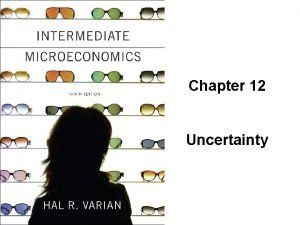Reasoning with Uncertainty http www um ac irkahani

























- Slides: 25

Reasoning with Uncertainty ﺩﻛﺘﺮﻣﺤﺴﻦ ﻛﺎﻫﺎﻧﻲ http: //www. um. ac. ir/~kahani/

Introduction § reasoning under uncertainty and with inexact knowledge § § heuristics § § experiential reasoning based on limited observations probabilities § § § ways to mimic heuristic knowledge processing methods used by experts empirical associations § § frequently necessary for real-world problems objective (frequency counting) subjective (human experience ) reproducibility § will observations deliver the same results when repeated ﺩﻛﺘﺮ ﻛﺎﻫﺎﻧﻲ - ﺳﻴﺴﺘﻤﻬﺎﻱ ﺧﺒﺮﻩ ﻭ ﻣﻬﻨﺪﺳﻲ ﺩﺍﻧﺶ

Dealing with Uncertainty § expressiveness § § § comprehensibility § § § can concepts used by humans be represented adequately? can the confidence of experts in their decisions be expressed? representation of uncertainty utilization in reasoning methods correctness § probabilities § § relevance ranking § § probabilities don’t add up to 1, but the “most likely” result is sufficient long inference chains § § adherence to the formal aspects of probability theory tend to result in extreme (0, 1) or not very useful (0. 5) results computational complexity § feasibility of calculations for practical purposes ﺩﻛﺘﺮ ﻛﺎﻫﺎﻧﻲ - ﺳﻴﺴﺘﻤﻬﺎﻱ ﺧﺒﺮﻩ ﻭ ﻣﻬﻨﺪﺳﻲ ﺩﺍﻧﺶ

Sources of Uncertainty § data § § § data missing, unreliable, ambiguous, representation imprecise, inconsistent, subjective, derived from defaults, … expert knowledge § § inconsistency between different experts plausibility § § “best guess” of experts quality § causal knowledge § deep understanding § statistical associations § observations § scope § only current domain, or more general ﺩﻛﺘﺮ ﻛﺎﻫﺎﻧﻲ - ﺳﻴﺴﺘﻤﻬﺎﻱ ﺧﺒﺮﻩ ﻭ ﻣﻬﻨﺪﺳﻲ ﺩﺍﻧﺶ

Sources of Uncertainty (cont. ) § knowledge representation § § § restricted model of the real system limited expressiveness of the representation mechanism inference process § deductive § § § the derived result is formally correct, but inappropriate derivation of the result may take very long inductive § new conclusions are not well-founded § not enough samples § samples are not representative § unsound reasoning methods § induction, non-monotonic, default reasoning ﺩﻛﺘﺮ ﻛﺎﻫﺎﻧﻲ - ﺳﻴﺴﺘﻤﻬﺎﻱ ﺧﺒﺮﻩ ﻭ ﻣﻬﻨﺪﺳﻲ ﺩﺍﻧﺶ

Uncertainty in Individual Rules § errors § § domain errors representation errors inappropriate application of the rule likelihood of evidence § § § for each premise for the conclusion combination of evidence from multiple premises ﺩﻛﺘﺮ ﻛﺎﻫﺎﻧﻲ - ﺳﻴﺴﺘﻤﻬﺎﻱ ﺧﺒﺮﻩ ﻭ ﻣﻬﻨﺪﺳﻲ ﺩﺍﻧﺶ

Uncertainty and Multiple Rules § conflict resolution § if multiple rules are applicable, which one is selected § § explicit priorities, provided by domain experts implicit priorities derived from rule properties § specificity of patterns, ordering of patterns creation time of rules, most recent usage, … § compatibility § § contradictions between rules subsumption § § one rule is a more general version of another one redundancy missing rules data fusion § integration of data from multiple sources ﺩﻛﺘﺮ ﻛﺎﻫﺎﻧﻲ - ﺳﻴﺴﺘﻤﻬﺎﻱ ﺧﺒﺮﻩ ﻭ ﻣﻬﻨﺪﺳﻲ ﺩﺍﻧﺶ

Uncertainty Management Techniques § Probability Theory § § Bayesian Approach Certainty Factors Possibility Theory Fuzzy Logic § Will be covered comprehensively in future ﺩﻛﺘﺮ ﻛﺎﻫﺎﻧﻲ - ﺳﻴﺴﺘﻤﻬﺎﻱ ﺧﺒﺮﻩ ﻭ ﻣﻬﻨﺪﺳﻲ ﺩﺍﻧﺶ

Basics of Probability Theory § § mathematical approach for processing uncertain information sample space set X = {x 1, x 2, …, xn} § § § collection of all possible events can be discrete or continuous probability number P(xi) reflects the likelihood of an event xi to occur § § non-negative value in [0, 1] total probability of the sample space (sum of probabilities) is 1 for mutually exclusive events, the probability for at least one of them is the sum of their individual probabilities experimental probability § § based on the frequency of events subjective probability § based on expert assessment ﺩﻛﺘﺮ ﻛﺎﻫﺎﻧﻲ - ﺳﻴﺴﺘﻤﻬﺎﻱ ﺧﺒﺮﻩ ﻭ ﻣﻬﻨﺪﺳﻲ ﺩﺍﻧﺶ

Compound Probabilities § describes independent events § § do not affect each other in any way joint probability of two independent events A and B P(A B) = n(A B) / n(s) = P(A) * P (B) where n(S) is the number of elements in S § union probability of two independent events A and B P(A B) = P(A) + P(B) - P(A B) = P(A) + P(B) ﻛﺎﻫﺎﻧﻲ - ﺩﻛﺘﺮ P(A) * P (ﻭ B) - ﻣﻬﻨﺪﺳﻲ ﺩﺍﻧﺶ ﺳﻴﺴﺘﻤﻬﺎﻱ ﺧﺒﺮﻩ

Conditional Probabilities § describes dependent events § § affect each other in some way conditional probability of event A given that event B has already occurred P(A|B) = P(A B) / P(B) ﺩﻛﺘﺮ ﻛﺎﻫﺎﻧﻲ - ﺳﻴﺴﺘﻤﻬﺎﻱ ﺧﺒﺮﻩ ﻭ ﻣﻬﻨﺪﺳﻲ ﺩﺍﻧﺶ

Advantages and Problems: Probabilities § advantages § § § formal foundation reflection of reality (a posteriori) problems § may be inappropriate § § inexact or incorrect § § the future is not always similar to the past especially for subjective probabilities ignorance § probabilities must be assigned even if no information is available § assigns an equal amount of probability to all such items § non-local reasoning § § requires the consideration of all available evidence, not only from the rules currently under consideration no compositionality § complex statements with conditional dependencies can not be decomposed ﺩﻛﺘﺮ ﻛﺎﻫﺎﻧﻲ - ﺳﻴﺴﺘﻤﻬﺎﻱ ﺧﺒﺮﻩ ﻭ ﻣﻬﻨﺪﺳﻲ ﺩﺍﻧﺶ into independent parts

Bayesian Approaches § § derive the probability of a cause given a symptom has gained importance recently due to advances in efficiency § § § especially useful in diagnostic systems § § more computational power available better methods medicine, computer help systems inverse or a posteriori probability § inverse to conditional probability of an earlier event given that a later one occurred ﺩﻛﺘﺮ ﻛﺎﻫﺎﻧﻲ - ﺳﻴﺴﺘﻤﻬﺎﻱ ﺧﺒﺮﻩ ﻭ ﻣﻬﻨﺪﺳﻲ ﺩﺍﻧﺶ


Bayes’ Rule for Multiple Events § multiple hypotheses Hi, multiple events E 1, …, En P(Hi|E 1, E 2, …, En) = (P(E 1, E 2, …, En|Hi) * P(Hi)) / P(E 1, E 2, …, En) or P(Hi|E 1, E 2, …, En) = (P(E 1|Hi) * P(E 2|Hi) * …* P(En|Hi) * P(Hi)) / k P(E 1|Hk) * P(E 2|Hk) * … * P(En|Hk)* P(Hk) with independent pieces of evidence Ei ﺩﻛﺘﺮ ﻛﺎﻫﺎﻧﻲ - ﺳﻴﺴﺘﻤﻬﺎﻱ ﺧﺒﺮﻩ ﻭ ﻣﻬﻨﺪﺳﻲ ﺩﺍﻧﺶ

Advantages and Problems of Bayesian Reasoning § advantages § § § sound theoretical foundation well-defined semantics for decision making problems § requires large amounts of probability data § § § sufficient sample sizes subjective evidence may not be reliable independence of evidences assumption often not valid relationship between hypothesis and evidence is reduced to a number explanations for the user difficult high computational overhead ﺩﻛﺘﺮ ﻛﺎﻫﺎﻧﻲ - ﺳﻴﺴﺘﻤﻬﺎﻱ ﺧﺒﺮﻩ ﻭ ﻣﻬﻨﺪﺳﻲ ﺩﺍﻧﺶ

Certainty Factors § § denotes the belief in a hypothesis H given that some pieces of evidence E are observed no statements about the belief means that no evidence is present § § works reasonably well with partial evidence § § in contrast to probabilities, Bayes’ method separation of belief, disbelief, ignorance share some foundations with Dempster-Shafer theory, but are more practical § § introduced in an ad-hoc way in MYCIN later mapped to DS theory ﺩﻛﺘﺮ ﻛﺎﻫﺎﻧﻲ - ﺳﻴﺴﺘﻤﻬﺎﻱ ﺧﺒﺮﻩ ﻭ ﻣﻬﻨﺪﺳﻲ ﺩﺍﻧﺶ

Belief and Disbelief § measure of belief § degree to which hypothesis H is supported by evidence E MB(H, E) = 1 if P(H) =1 (P(H|E) - P(H)) / (1 - P(H)) otherwise § measure of disbelief § degree to which doubt in hypothesis H is supported by evidence E MD(H, E) = 1 if P(H) =0 (P(H) - P(H|E)) / P(H)) otherwise ﺩﻛﺘﺮ ﻛﺎﻫﺎﻧﻲ - ﺩﺍﻧﺶ ﺳﻴﺴﺘﻤﻬﺎﻱ ﺧﺒﺮﻩ ﻭ ﻣﻬﻨﺪﺳﻲ

Certainty Factor § certainty factor CF § § ranges between -1 (denial of the hypothesis H) and +1 (confirmation of H) allows the ranking of hypotheses difference between belief and disbelief CF (H, E) = MB(H, E) - MD (H, E) combining antecedent evidence § use of premises with less than absolute confidence § § § E 1 E 2 = min(CF(H, E 1), CF(H, E 2)) E 1 E 2 = max(CF(H, E 1), CF(H, E 2)) E = CF(H, E) ﺩﻛﺘﺮ ﻛﺎﻫﺎﻧﻲ - ﺳﻴﺴﺘﻤﻬﺎﻱ ﺧﺒﺮﻩ ﻭ ﻣﻬﻨﺪﺳﻲ ﺩﺍﻧﺶ

Combining Certainty Factors § § § certainty factors that support the same conclusion several rules can lead to the same conclusion applied incrementally as new evidence becomes available CFrev(CFold, CFnew) = CFold + CFnew(1 - CFold) if both > 0 CFold + CFnew(1 + CFold) if both < 0 CFold + CFnew / (1 - min(|CFold|, |CFnew|)) if one < 0 ﺩﻛﺘﺮ ﻛﺎﻫﺎﻧﻲ - ﺳﻴﺴﺘﻤﻬﺎﻱ ﺧﺒﺮﻩ ﻭ ﻣﻬﻨﺪﺳﻲ ﺩﺍﻧﺶ

Characteristics of Certainty Factors Aspect Probability M B M CF D Certainly true P(H|E) = 1 1 0 1 Certainly false P( H|E) = 1 0 1 -1 No evidence P(H|E) = P(H) 0 0 0 Ranges measure of belief measure of disbelief certainty factor 0 ≤ MB ≤ 1 0 ≤ MD ≤ 1 -1 ≤ CF ≤ +1 ﺩﻛﺘﺮ ﻛﺎﻫﺎﻧﻲ - ﺳﻴﺴﺘﻤﻬﺎﻱ ﺧﺒﺮﻩ ﻭ ﻣﻬﻨﺪﺳﻲ ﺩﺍﻧﺶ

Advantages and Problems of Certainty Factors § Advantages § simplementation § reasonable modeling of human experts’ belief § § § successful applications for certain problem classes evidence relatively easy to gather § § expression of belief and disbelief no statistical base required Problems § partially ad hoc approach § § § theoretical foundation through Dempster-Shafer theory was developed later combination of non-independent evidence unsatisfactory new knowledge may require changes in the certainty factors of existing knowledge certainty factors can become the opposite of conditional probabilities for certain cases not suitable for long inference chains ﺩﻛﺘﺮ ﻛﺎﻫﺎﻧﻲ - ﺳﻴﺴﺘﻤﻬﺎﻱ ﺧﺒﺮﻩ ﻭ ﻣﻬﻨﺪﺳﻲ ﺩﺍﻧﺶ

Possibility theory It is dealing with precise questions on the basis of imprecise knowledge. Example: An urn contains 10 balls, several of them red. What is the probability of drawing a red ball at random? We have to define “several” as a fuzzy set, e. g. : f {(3, 0. 2), (4, 0. 6), (5, 1. 0), (6, 1. 0), (7, 0. 6), (8, 0. 3)} The possibility distribution for p(RED) is now given by f(p(RED)) = SEVERAL/10 ﺩﻛﺘﺮ ﻛﺎﻫﺎﻧﻲ - ﺳﻴﺴﺘﻤﻬﺎﻱ ﺧﺒﺮﻩ ﻭ ﻣﻬﻨﺪﺳﻲ ﺩﺍﻧﺶ

Possibility theory f(p(RED)) evaluates to {(0. 3, 0. 2), (0. 4, 0. 6), (0. 5, 1. 0), (0. 6, 1. 0), (0. 7, 0. 6), (0. 8, 0. 3)} Meaning e. g. that there is 20% chance that p(RED) = 0. 3 So f(p(RED)) can be regarded as a fuzzy probability. ﺩﻛﺘﺮ ﻛﺎﻫﺎﻧﻲ - ﺳﻴﺴﺘﻤﻬﺎﻱ ﺧﺒﺮﻩ ﻭ ﻣﻬﻨﺪﺳﻲ ﺩﺍﻧﺶ

Summary § many practical tasks require reasoning under uncertainty § § variations of probability theory are often combined with rule-based approaches § § missing, inexact, inconsistent knowledge works reasonably well for many practical problems Bayesian networks have gained some prominence § improved methods, sufficient computational power ﺩﻛﺘﺮ ﻛﺎﻫﺎﻧﻲ - ﺳﻴﺴﺘﻤﻬﺎﻱ ﺧﺒﺮﻩ ﻭ ﻣﻬﻨﺪﺳﻲ ﺩﺍﻧﺶ
 Reiters
Reiters V
V Inductive vs deductive
Inductive vs deductive Deductive logic definition
Deductive logic definition Inductive reasoning is reasoning based on patterns
Inductive reasoning is reasoning based on patterns Deductive and inductive reasoning
Deductive and inductive reasoning Example of inductive argument
Example of inductive argument Inductive and deductive reasoning geometry examples
Inductive and deductive reasoning geometry examples Http //mbs.meb.gov.tr/ http //www.alantercihleri.com
Http //mbs.meb.gov.tr/ http //www.alantercihleri.com Siat.ung.ac.id krs
Siat.ung.ac.id krs Slack
Slack Cmc uncertainty
Cmc uncertainty Uncertainty management in rule-based expert systems
Uncertainty management in rule-based expert systems Standard deviation
Standard deviation Implied uncertainty spectrum
Implied uncertainty spectrum Cl alt relationships
Cl alt relationships Uncertainty vs risk
Uncertainty vs risk Heisenberg uncertainty principle
Heisenberg uncertainty principle Uncertainty of a protractor
Uncertainty of a protractor Heisenberg uncertainty principle
Heisenberg uncertainty principle Photon uncertainty principle
Photon uncertainty principle Significant figures cartoon
Significant figures cartoon Systems engineering with uncertainty
Systems engineering with uncertainty Gaussian standard deviation
Gaussian standard deviation Peters uncertainty in acoustics (epub|pdf|mobi)
Peters uncertainty in acoustics (epub|pdf|mobi) Expanding strategic scope
Expanding strategic scope
